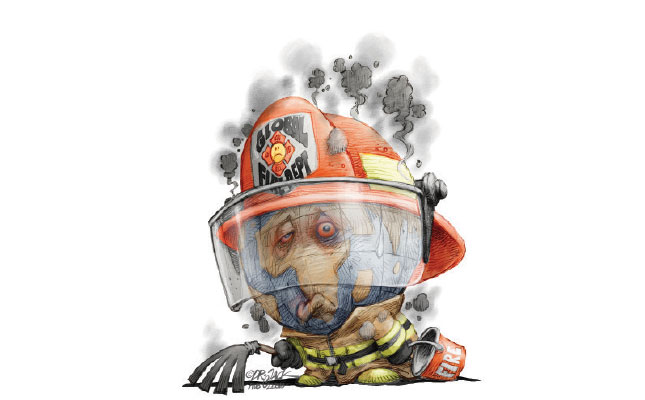
Fire is changing because we are changing the conditions in which it occurs. Not all fires are harmful, and not all fires need to be extinguished as they serve important ecological purposes.
However, wildfires that burn for weeks and that may affect millions of people over thousands of square kilometres present a challenge that, right now, we are not prepared for.
Lightning strikes and human carelessness have always sparked, and will always spark, uncontrolled blazes, but anthropogenic climate change, land-use change, and poor land and forest management mean wildfires are more often encountering the fuel and weather conditions conducive to becoming destructive.
Wildfires are burning longer and hotter in places, they have always occurred, and are flaring up in unexpected places too, like in drying peatlands and on thawing permafrost.
Last year, fires that got out of control in the Pantanal, the world’s largest tropical wetland in Latin America, destroyed almost a third of one of the world’s greatest biodiversity hotspots, and there are now genuine concerns that this wetland will never fully recover.
Not only can wildfires reduce biodiversity, but they contribute to a climate change feedback loop by emitting huge quantities of greenhouse gases into the atmosphere, spurring more warming, more drying, and more burning. The heating of the planet is turning landscapes into tinderboxes, while more extreme weather means stronger, hotter, drier winds to fan the flames.
Too often, our response is tardy, costly, and after the fact, with many countries suffering from a chronic lack of investment in planning and prevention. This report makes it clear that the true cost of wildfires, whether financial, social or environmental, extends for days, weeks, and even years after the flames subside.
Eliminating the risk of wildfires is not possible. There are management actions that can be taken to mitigate the risk of wildfires and their impact, including the restriction of activities that might lead to accidental fire ignitions, management of vegetation and vegetation debris (wildfire fuel) to decrease fire hazards prior to wildfires occurring, management of wildfires when they do occur, relocation of threatened populations and assets during a wildfire, and more long-term sensitive land-use planning that accounts for multiple risks.
However, it is practically impossible to entirely remove the risk posed by wildfires. Consequently, more communities around the world must learn to live with the residual risk of wildfire and plan appropriately to minimise the disruption it may cause.
Controlling wildfire behaviour
When it comes to fighting wildfires, technology has very clear limitations. This is because controlling wildfire behaviour is highly dependent on the prevailing weather and fuel conditions, as well as accessibility. It is often only a change in weather that can help bring a wildfire under control.
Therefore, the limits and appropriateness of suppression strategies and tactics and the associated suppression resource types must be well understood. This can ensure that resources are employed efficiently and effectively when conditions are most suitable and that the risk to firefighters is minimised.
Managing the available fuel before a wildfire breaks out through planned burning (prescribed or hazard reduction), or other hazard mitigation actions (like physical removal or chemical treatment), can reduce the intensity and thus likely impact of a wildfire.
The use of prescribed fire for the management of fuels can effectively reduce wildfire size, fire-line intensity, and fire severity. Managed fuels improve the effectiveness of fire suppression efforts, increase firefighter safety, and decrease detrimental impacts on ecosystem services.
Traditional knowledge of land management in many regions, particularly the use of fire for fuel management, can also be an effective way of implementing hazard reduction efforts while maintaining ecological values and biodiversity. However, prescribed burning is not without its risks, including decreased air quality and the potential for unintended consequences.
It is essential that the effect of prevailing weather and fuel conditions on wildfire behaviour and the resultant efficacy of hazard-reduction measures be understood.
Integrated wildfire management is key to adapting to current and future changes in global wildfire risk. It consists of five interlinked and often overlapping phases: review and analysis, risk reduction, readiness, response, and recovery (the 5Rs, also known as PPPRR: planning and prevention, preparedness, response, and recovery).
- Review and analysis include the collection of data and information on past events. Understanding critical factors (like fuels, weather, fire behaviour, ecological response, fire management response, general-public response, and post-fire recovery processes) and causal relationships (such as fuel management and fire mitigation effects) helps improve wildfire mitigation and management.
- Risk reduction includes many possible actions aimed at reducing the likelihood of wildfire. For example, fuel management (at spatial scales from householder to wilderness), resilient building design, land-use planning, and reducing the incidence of arson and accidental ignitions.
- Readiness. Even with effective risk-reduction measures in place, fires will still occur. Communities and fire services need to be prepared. For residents, this may mean having an evacuation plan or a well-conceived plan for remaining in place to protect assets. No matter what preparations are made, they need to be based on an awareness of the nature and risk of wildfires. Fire services and other relevant organisations also prepare for wildfires by having trained personnel and appropriate technology, systems and process in place.
- Response relates to the actions taken to manage a wildfire when it does occur, including resource allocation and management (personnel and equipment) for safe suppression efforts, wildfire alerts and fire status updates, incident management, and evacuations.
- Recovery includes all remediation efforts during and after a wildfire disaster. Since it is not possible to prevent all fires, nor desirable from an ecological standpoint, recovery focuses on mitigation and actions that can help to reduce the potential adverse impacts a wildfire might have.
Understanding each ecosystem
Wildfire management is challenging and will become even more so with the increasing risk and threat of wildfires. Worsening risk profiles are increasing the demand for detailed and timely intelligence on fire likelihood and threat.
In many regions of the world, the majority of fire management expenditure is on fire response, that is, direct suppression of wildfires as they occur. For this to be effective, understanding of the ecosystem in question, its vulnerability or adaptation to fire, amount of available fuel, the assets, infrastructure and lives at risk, and the likelihood of a fire outbreak developing into a wildfire and its likely behaviour is essential.
The views expressed in our weekly opinion piece do not necessarily reflect those of Farmer’s Weekly.
This is an edited excerpt from the United Nations Environment Programme report titled ‘Spreading like Wildfire: The Rising Threat of Extraordinary Landscape Fires’.













